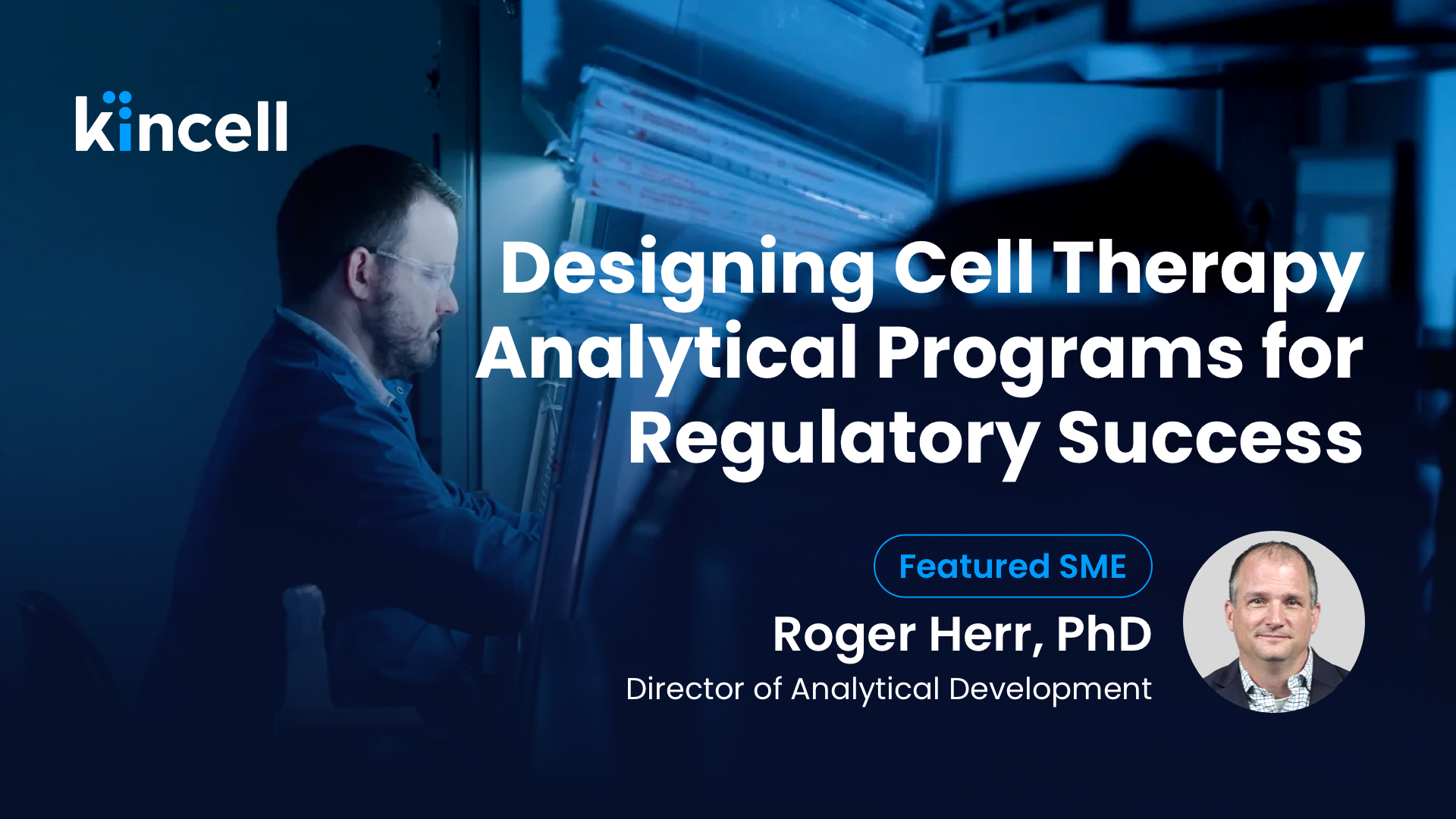News & Insights

Many cell therapies target complex conditions with unmet medical needs and often achieve designation of one of the FDA’s Many cell therapies target complex conditions with unmet medical needs and often achieve designation of one of the FDA’s expedited programs, such as Accelerated Approval or Regenerative Medicine Advanced Therapy (RMAT). These pathways can shave years off clinical study timelines, but they also compress the scientific work that underpins a well-crafted Biologics License Application (BLA). In practice, this expedited process typically means that Chemistry, Manufacturing, and Controls (CMC) teams perform critical development, validation, and manufacturing activities in parallel, leaving significantly less time to develop the full suite of analytical methods needed for a traditional BLA filing.
This tension between speed and analytical robustness sits at the heart of many of the Complete Response Letters (CRLs) that have recently delayed some cell therapies reaching the market. However, a conversation with Roger Herr, PhD, Director of Analytical Development at Kincell Bio, offered pragmatic insights on how to design, prioritize, and balance cell therapy analytics to meet the need for efficiency and speed early on, while being constructed with a direct and efficient line to later phases of development.
Challenges Transitioning from Discovery to Development Analytics
Innovators commonly “retool” their research scientists who brought the viable candidate to the table into analytical development or process development roles. However, the mindsets and skillsets are incredibly different in that discovery work requires exploratory, directional assays, while clinical development programs must deliver robust and reproducible methods and manufacturable processes. It is important to note that many late-phase analytical issues stem from critical decisions made during early development, like complex activity/potency assays, flow cytometry assessments, and others.
It is essential to transition from scientists who excel at discovery research to development experts with the knowledge and experience to help make early critical analytical decisions and guide the sponsor through IND and ultimately to BLA success.
Why Early Analytical Investment is Worth It
Under the pressure of expedited timelines and tight budgets, teams often defer the implementation of system-suitability controls and method qualification, only to discover, at the IND or perhaps in Phase 2, that the data aren’t reliable. The result is costly method redevelopment, comparability studies, and IND revisions. Perhaps more importantly, it’s lost time to get life-saving therapies to patients in the commercial setting.
“Given compressed timelines and budget constraints, many innovators think about analytical investments in a phase-appropriate manner,” commented Herr. “While we never advise overengineering, phase-appropriate should not mean short-cuts, as insufficient analytical method development will require future assay redesign and method comparability studies, due to unreliable data. This kind of approach ends up costing a lot more in the long run.”
It is essential to recognize that when analytics are unreliable, decisions are not based on a solid foundation, resulting in a high likelihood of optimizing for inappropriate endpoints or critical quality attributes. Well-constructed analytics are the foundation for any cell therapy program, as without trustworthy data, informed, defensible process changes cannot be made.
What Are Cell Therapy Programs’ Early-Phase Analytical Priorities?
Safety methods are always non-negotiable, but early Phase I success hinges primarily on precision. Precision is a measure that refers to the ability to obtain the same answer repeatedly when conducting a given assay on the same substrate. Accuracy, on the other hand, refers to how closely a method’s result matches the accepted reference value.
Early-phase analytical development typically emphasizes precision over accuracy, particularly for methods such as cell count and viability, as this foundation supports dose escalation studies in Phase I clinical trials. Additionally, due to their complexity, it is essential to begin building potency and characterization matrices that are aligned with the mechanism of action (MoA) early in development. Since no single method can effectively measure a cell therapy’s mechanism of action, a MoA-aligned potency and characterization matrix—which connects quality to biology, accounts for variability, supports comparability, and correlates with outcomes—guides development decisions and builds regulatory confidence for IND submissions. This approach is often factored into the potency assurance strategy.
For allogeneic programs, it is important to initiate donor qualification early and ensure that the correlation of donor attributes with potency and clinical outcomes begins as soon as possible. Additional safety concerns with gene-edited products warrant an appropriate suite of assays to assess on and off-target edits, as needed.
The Best Opportunity to Save in Early-Phase Cell Therapy Development
“Pursue more standard process development strategies in the early phases,” advises Herr. “But channel those process development savings into analytical investment. Timelines and budgets are, of course, pressured in early development, and sacrifices are necessary to keep a program running on time and within budget. Knowing that process changes are inevitable as you learn more about your product, strategic phase appropriate early-phase process development is the area where time and money can potentially be saved.”
Reliable analytics, coupled with a well-thought-out retain strategy, help define and enable the process changes needed to support later-stage clinical studies, without significantly slowing down the overall development of the program. For instance, utilizing commercially available culture vessels with GMP equivalents in early process development will likely save a significant amount of time and money, especially if the vessel has a scale-down version that allows for effective process characterization later on. As processes mature, analytical and characterization insights will efficiently guide the effort, making comparability studies much easier, more efficient, and more interpretable.
Navigating Regularly Framework Challenges
Today’s FDA guidance still leans on “mAb-era assumptions” that don’t directly map to cell therapies. “For example, regulators often push relative potency paradigms that compare each lot to a fixed reference and demonstrate parallel dose–response curves,” Herr commented. “In cell therapy, every lot, whether autologous or allogeneic, is inherently different, and parallelism between reference material and test article should not necessarily be expected. This potential misdirection leads to development teams spending time forcing assays to fit models that don’t reflect the needs or realities of cell therapies.”
Thankfully, the FDA is actively working to strengthen cell therapy guidance. As the industry and regulators alike continue to advance cell therapy knowledge and understanding, the regulatory framework continues to mature. In the meantime, Kincell’s cell therapy technical expertise and regulatory experience are invaluable for guiding programs along a path that is not exceptionally well defined.
Kincell Supports Meeting Regulatory Expectations & Cell Therapy Program Success
A well-thought-out analytical strategy is necessary to meet rapidly evolving regulatory expectations and to ensure program success. Early investment in analytical development enables data-driven process changes and enhances understanding of both processes and products, thereby guiding the program throughout its entire lifecycle.
Kincell has built deep technical development expertise, and our team often provides novel ideas and innovative approaches to method development challenges. Additionally, we have extensive expertise in navigating the emerging cell therapy regulatory framework and are actively collaborating to advance the cell therapy industry as a whole. Let’s discuss how Kincell Bio can help support your program.
Featured SME

Roger Herr, PhD
Director, Analytical Development
Roger Herr leads analytical development at Kincell Bio, where he builds phase-appropriate, scalable assay strategies for cell therapy programs and is known for transforming complex biology into reliable data. Before joining Kincell, Roger held analytical leadership positions at influential organizations in the biologics space, including Inceptor Bio and Arranta Bio (now Recipharm Advanced Bio). Roger earned his Ph.D. in Molecular Basis of Disease from the Medical University of Ohio at Toledo and a M.S. in Clinical Laboratory Sciences from Michigan State University.
